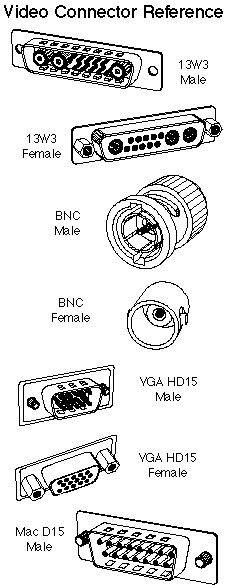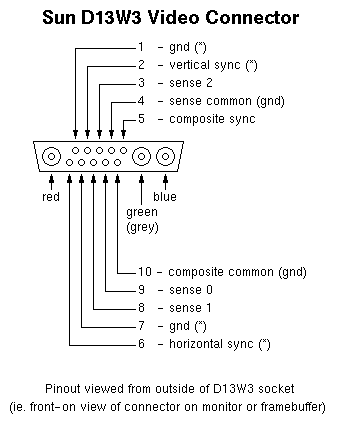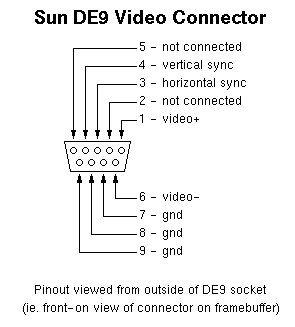Sun Framebuffer Video Connector Pinouts
DE9 and D13W3 and other connector types for comparison
Compiled by Craig
Dewick






Sense codes are used by the framebuffer to determine the maximum display size that a Sun monitor can support.
The default display mode for almost all of Sun's colour video framebuffers is 1152 x 900 pixels @ 61.8 KHz x 66 Hz (or, depending on the monitor sense code, a 76 Hz variation).
The maximum display size that a framebuffer can support is dependent on the ammount of VRAM. Most older 8-bit-only framebuffers have 1 MB of VRAM, which permits the standard display mode and not much else (except some smaller display sizes).
Some framebuffers, like the Sbus TGX+, have more VRAM (the TGX+ has 4 MB), and can support larger display sizes than the default. A common misconception is that the TGX+ can support 24-bit colour, but it can't. It uses the same BT-458 pallette DAC (from Brooktree) as the original GX and TGX models.
The Sparc LX and Sparc 4 can both have a 1 MB VSIMM fitted which increases the total ammount of VRAM to 2 MB. This allows larger display sizes than just the standard to be used (still only in 8-bit mode though).
The cg14 on-board framebuffer in Sparc 20's and Sparc 10SX's is a 24-bit colour framebuffer, so it requires a much larger ammount of VRAM. 4 MB of VRAM (via a 4 MB VSIMM) is needed for standard 1152 x 900 24-bit color, while 8 MB of VRAM (via an 8 MB VSIMM) is required in these machines to support 24-bit colour in 1280 x 1024 mode.
A second VSIMM, along with a 501-2488 auxilliary video board can be fitted to Sparc 20's to add a second 24-bit head where two 24-bit colour framebuffers are required.
Ultrasparc machines have more video options since they can support Sbus framebuffers in older models, while more recent models support PCI-bus framebuffers and most of these (notable exceptions being Ultra 5's and the SunBlade's) also have UPA-bus slots that give certain framebuffer models direct access to the Ultrasparc CPU's native bus.
UPA-bus framebuffers include the Creator2D and Creator3D line, the Elite3D, and the Expert3D. All of these are much more sophisticated than the older Sbus framebuffers, thanks to advances in technology.
PCI-bus framebuffers include the PGX-32 which is like a PCI version of the Creator3D, and the PGX-m64 that's an entry-level framebuffer which only provides 8-bit colour support just like the older Sbus TGX's.
For loads of technical and operation information about Sun's framebuffers, etc., check out David Tong's Sun Framebuffer FAQ, Sun Colourmap FAQ and Sun Framebuffer History FAQ's which are now hosted locally since these documents don't have any other Australian presence.
taken from http://lios.apana.org.au/~cdewick/sunshack/data/framebuffers.html